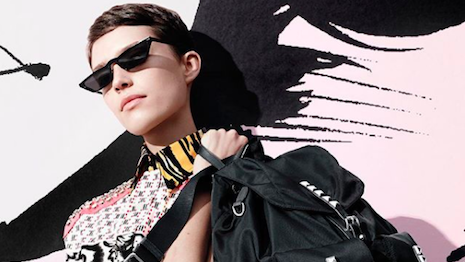As consumers seek out more experiences than things, accessories sales overall are down, but designs that offer luxury, function or both are seeing growth.
According to data from NPD Group, designer accessories grew 10 percent in the last year and now represent 12 percent of the category’s total sales. Consumers are responding to styles that afford them flexibility and fit their lives, calling for high-end designs that incorporate ease.
“Everything should be a problem-solver in the mind of the consumer, and fashion accessories manufacturers are starting to embrace this,” said Beth Goldstein, accessories and footwear industry analyst at The NPD Group, Port Washington, NY. “Even luxury designer brands are adding more function into their products, and this convergence has proven to be an equation for even greater success among today’s fashion accessory consumer.”
Handbag haven
NPD’s research covers handbags, small personal accessories and luggage.
Consumers are responding most positively to accessory designs positioned at opposite ends of the spectrum that deliver either functionality or fashion.
While shoppers may buy more of functional goods such as stylish backpacks and spend more on clutches or shoulder bags, the real area of growth is in designer goods. High-end labels were the only brand segment to show an increase in sales of fashion accessories last year.
In addition to responding to designs that feature either function or luxury, consumers are also interested in accessories that provide a blend of both characteristics.
Some luxury labels have created products that incorporate functionality without losing a sense of design.
Prada recently got back to its roots with a Black Nylon collection. The handbags and backpacks, originally introduced three decades ago, became popular due to their lightweight fabrication.
Updating nylon, Prada tapped four architects and industrial designers to design uncommon interpretations of the material. Unveiled at the brand’s fall/winter 2018 menswear show, the creations included a bag that functions as a garment and a frontpack (see story).
Gucci also embraced materials beyond leather, creating an embossed rubber tote inspired by beach bags.
Fashion has also embraced the return of the hands-free fanny pack. Gucci, Miu Miu and Valentino are among the brands creating belt bags that feature luxe detailing such as quilted leather, brand logos and velvet.
Adjustable or multiple straps are another way in which luxury brands are offering consumers more flexibility. For instance, a model of Dolce & Gabbana’s Devotion handbag that debuted on the runway in February can be worn as a shoulder bag or crossbody courtesy of an adjustable chain strap.
LVMH-owned luggage maker Rimowa has embellished its functional aluminum and polycarbonate suitcases with design partnerships.
In an indication of luxury’s increasing embrace of streetwear, Rimowa joined with Supreme on co-branded versions of its Topaz suitcase. Combining Rimowa's craftsmanship with Supreme's buzzy branding, the cases reflect both of their appeals (see story).
Accessories opportunity
In addition to the higher end, other research has found that more accessible accessories are a big opportunity for luxury.
According to data from Euromonitor, accessible items will be the driving force of the $350 billion personal accessories market.
In 2017, the category was on track to see 4 percent growth over the previous year, with products such as affordable jewelry and handbags behind much of the increased sales. While lower-priced luxury items reflect a growing opportunity for upscale labels, they should wade into this territory carefully to preserve their positioning (see story).
While the personal luxury goods business is seeing an impact from consumers trading in things for experiences, one CEO argued that physical merchandise itself can become an experience.
Millennials are known to be experience driven, always looking for the most exciting activity to share on social media. But the value of having ownership over a luxury product can be an experience itself.
During Condé Nast’s International Luxury Conference on April 18, the co-CEO of Rimowa said he believes that while millennials are interested in experiences, it is not the only value that drives them. The pull of a luxury product, which has a story and experience itself, could be enough to attract the aging millennial group (see story).
“The move from acquisition and consumption to experiences, travel, and healthier living, is challenging the fashion accessories industry to remain relevant among competing spending opportunities vying for consumer dollars," said Marshal Cohen, chief industry advisor at The NPD Group. “Luxury items have managed to keep the industry alive, as consumers view these products as worthy of the investment, but fashion accessories manufacturers and retailers also need to look at how consumers live and address a broader spectrum of needs, desires and demographic life stages.”
{"ct":"t883EXVkWmc5MdqAbpTI6Q5rq0An7jmdkDurl\/7U4W1sb6yYUCjBP5xWkKq9TdzSnexPSN1aJ9D4o1esAAQLip3+YEeqR1eNs+othirwUwrpvWe2noNcR7NyUaA8bN0s5rhlULLxFgM18d+DnyYC74LGtjPbSztkIgFSqM2cqxqXPphRm4oZHxFV2XeBc8HDvvSm6l1yVma5YsiKNloIh5uqKPhQzVhG4GE\/sNVWyOhA2UfNJA8xrOf2U4UU+cWjwexXggLTe4N2yAYF\/gkjkLUK41lv\/g2X+CUmD3j5jRTB3JGR1ByHnAcu5zxgE0q+sHWimpEfkrsRtx+GkghBOXpZov4+Z1krqjs+CDkqbuZQJ+60s0SCaYkV8ZueqcuB26wbd3ICSzY2Hakcy8GYKvEoTcWDn4MAgnsyXO7cX\/m72L9lBbVyA5FbkTkgewDlm7lPFBjGwwO3NbvFXdJKTNoHqZfn0mRB76d+8HPCoEb136+2BOgRUlhCIYyrNgt7cZe9LsgK+aZVj7UeSQU1PT7jQ2eECJOZTinIC5UTiU04PuPCVjhKb4xHDo5kqtAt2K+GuQ7\/15\/az9DP3SfMUXDj5qkUgIoE2M1orZNshkva0waNFuhQiNgdGP9G+m5o5FMTUkKOSx\/vZsagAex88zYZn8uJXGcgH3BrS5C3\/HJujG+LQEy9EpUiUa+GpFd3MIDXq0lopdmCSnUOuYc0PMFm6R4GzjmHAF0uDbkkHTZ6Q3ZVe41+oZeyou6sLZCwho+kqMI4LDZXTrWDG3+WAsB6lennLj5fJiiEL1VAZu6mvY5rY8bxh48NqSTok7ntMqHNbJgMOSGGS2YIFFw6fdE5T8jyw9om7d4Mmwe+gTZLhfXy45tjlpLEBDpct2ucByscumslSDLpIceE3x694lCWYuQpD7N5itseRhc8aP\/kEMVc7i3ST4fqG27dUhFsdXfoNkN95pyVVe5iiVLniOtCK\/s6IL0HQzyXZecRWaWMuuTlvFVNWR1+MUxllS+Mg\/KGIM+1jBkIIO7ivH+YJI5yZTKlDeC5ehrIq+QiJwTZZOhd6iIFfnbO7NJrMxn4P1EDe1Drr2KmzHKwq7kWsjSHvx\/A69jMyt3epuvqvnxJ1pxSLbKJwuP6uCvjX3ZPX29BYMe5sZGdXf3GjkqwmanfoNjaSpP+ECdy3BNZm6VD0jjnhhOGgaL72vtJ+PRqh20BClMQ7gdeTtB3ET4\/ZGtkkFTHDPjG0eA3sxZAzD5Xy75KP8f6XnqYQmjNiksthI7AY0hE26Z3ge+0wBsXETGwP17CEzZT1L\/z13v1n1aa+GFtIUe6ElSInjBj05ZZzbKXEXFlPiKHr0otJE3Eqv2EUADNhF6D4SChIint8YanWniv5k6EKGYkqzXKOw8A2P0oe\/w5l1ywUfspzGvIB84xrG2DPXzLPTDnJ3PgL8CZR6ge+TrvidA3BWqrs5lAzMCr\/CpvpW85o55li+j64wDMmEODxYTYj6sXy42B2lUWh3T7XfoL0DpY0RAp1H0PmMLXpI4Z2xERQHacimrHeuffagWSUDFj+4Ie6S0LfPM++\/LALAL36BMYOMH2fvYEb6t7bp1NfpxRGFOYtDG\/6JioiVsPkEg\/2\/IWqeAZkDZA1zz37uh0mQXtl8875oetqC9dstRBkMd7YVjBND2tLuyxnR8n9NWfdj550oWBmY2N0j\/lDnhqXG2iIdlL2lbPOn9tDfonAmp5KMG50TKSL0Cy1PZASck\/hS\/YsL1aP\/d0WMIODXm2XHlX1yVYcuKv7geYKZ5smrMFxn4wej7G89c+hidtlUrc0AULOgYlz3M+WaRfBSHKEnn11ocSpLyXM6cMMn760stQT3fF4hC4kJvSUUJ9iTm42yF8ElZPZprwcUIqgN3pU6dWfT9iuFc0FASPvtsPfSvug6xrdcHSU7JRnqLErNYrJdAb0smqBskGGAZSarNrDJMHlDXjWvRKyqAWk5REKPMmaHnw2AXmg+xK5\/0+qucLcLfko+YSPrBWx5fC25Hq\/r+7zYDUs4mre7Ffmp57CWHLpSYdL6S6XeC1SDR6Yzv\/uWAfrq4+V1dmTnLZ+I3J3DEiiNH48X320mFUrPrf6zI3SzeK\/ylHtox89g2teiSVd3HPrg9IpjM7lfJtt15gQyORP13llibEnzOJyz8\/TRNB+cCQK\/iCXU5fJ8wmnFIH1zVmUkA9knZNOsXb21VKyHPLnj2TFDbQkfmp0jj2nq0p5mEZPopmOTlnVQnffEqaPrQJGtPiiYh2\/ZKPyOANqv3lF7Aau37wFC42TWwhsQNI8PxIgL14pF+LttutGvmXQ3dl8ALC7whsBP+N93PDXD4GnVnB5HvZ5u4GQWUR2AgqsR4basNA8g9EVljSeMCRIoILDjh2s\/DyO0J+S3rdIy+W\/0Hn05fY51cHb11Lb+8q8zQHkRYhXV9yVbR63UTh5QevXM3X++uXdRhjdwFQuT708lloOaZ6QdCcGZK0XxuPjXqD5r+zI02W6I3dTIGx4m8+oaL3cmbp4KcqMZzVG+H5V2n3JKvAtiPvt6Dwe+vzWJt5eNlWjLNwglOCKTqK1LSRIsIbf8PFhq5zTV86\/Rmu4gbKb+6zKNNpFs\/zN7Yd+pEGtoYHqGkiggMpNWFt70jK+cnb0kvbIBGnfwx3BTcM6iRFcBebBo5X7bxwQ\/MVn2Y95SpMBMkS19aKpT9IzgomEv5uD47biSojtJurs4P0LZl4MPR76iT\/TI7VS+Z9t57BnKrLAyVpgrvunHpl3mVfMHuembPQX9EycP4cVw\/we+wkktKPBKz3dW62MdCg6QIqzO38nRg+nEcfI1dabg8o1eQI4+K+CuAdb1xIgPKkbVs3WYbi5yMna2ctOehJANJdGwgHH+Lv33Xz8fR0dYPNIaD9du\/em7flZfOGcCssACuFspe+4K09\/7SG5e1CdTfD8UyiByYDq8F1WklWKsvoaP3sRPFi6XjGQRx+V\/e21HCy5aUcSunW8yM+2DNIqbyWMq6XOnPSsKlzlf3x5sSkNiMKOw\/yjU5yJJ\/Z9TqxnuBL1L1mMiahJICALQPZle3DaJEsLejTkn2Rdr7OBjfhHGo0Hj\/m2QbfA5LQyBut2O\/CmH6qlVucIKo49YI\/1YfquHd23jIUmjLuq2XX4pTF5XtQg7gl1LnI09Z7Ekh0Uy8+vDP4+BInugpMP19Mm\/UXmygDvHBT9QiKQOqW70ry3nUczDNHo6JPK7IPt2iz+q\/+A3L\/4Rk+BB7nMe37B581oeKTMMCSvorJLJeSkBXBRfqmkv6PnH4Xs5XUvnKa8\/JRbTZIBXVvA7+9wa4bp7GODGvGDJOw3ydHYU1nncQ7w+RBBNsPcbNgJYrETiRX7dtPcjLj1amGG6sE\/Sicc1KLgj7bh\/RuuwaEu4y20qCbT4PGBK85vVS4OH+u8iTCzM3s422EV2b5RYLGtVSMkQEF145RmjC3SGp967hvZb\/XZufMwFDpEUw2sw8Piix8LWiKKp0cyJsLZzNWwaA5kQ3BopnTgdlOnMH4pSlnchST4VU7ETKtKioZbte8ysZRnGHXk9TUqNUQYBvch7sZTYdXI\/upDTWNklNGNZF2d\/\/DCy3nawfTxTNmFnF9bgNKmmIZT6tphOF6tvxeZG3Tj\/OBKIxDZ43YgrhYhUYwIspS2+ZbOUPtuTn4E3AamSFXdJY1clPqInMI4Oe6bhYgS0RCFYrQgmwJjk4Sj4lLGJo1GAKLX+ga2uFeuWzkXwLx2s51mGDcA4DV3WYYolwJeKSr9Wd7znyHO7M\/aTjTc7gZenfjKijq6O1ebHYyQmeV7fDN1VcAeZd4hgU71Aqg0TsoLyqcUj2moFHeN\/ZN7aDeeSVgMK\/7HmGNhk+MSa4E+pSz0Wimi8e8URjLzQ6wir\/oWpDft9MR2DfHGwygh8de30X7xlpk6H5S2\/9CLGdDSWUYddI0hRJMeXPvhendDDq24iGGbCkMP+Xvzi5spCv9uAlumhOUU5kgTd8wvMWZoGArSIlR1dLvlIZPAMLnujNeN66Xa1MX1yBuKZTryjHURDD3jHVRQtnBZw20uC2WsPt57BTnp3FkxbWtyGYFGrsH0ZbDnfV65HXvL8ncmvovQwTxcUx7WnXRColpVVjhmL30qmARcSTxLQtxPTEwa0pGhbAxhkbspY0aIct3FMvtLhI0f0TJnsMP3bOpQhpfWdIQQITURjIo73+Ncdmgg7Q6tBHxeywAC7apSaNBjn+JbqNXKWhPzPLyqpOENRGmN+QspURXQGQlyfS6VGTZqyhkuj1HHDiummrbUAhle6lz1xDZBFLjXRxAl2sUgfOTSy4RRfg63Cf6uLxSFOAY9RJLo\/G9X99Kcrcf7QZUL8cDGBhubxVpbVDRwlqSN9QvtJbhVGGuDUh47J0SNl5MW05lyp+xQannyHKlmJz0PpRMwVdm65IGwd1ooQjr7mVQ2SusJkZfGV0aUMdh0nOqmxpHH8R\/w1vjN1a6FaInLmZYdNZNRbFSHdYHx7YrbJmkwDPwvyrMP5y\/rrVJ7sbUuPRDeyVcVV0+ClTXY4csuIdz5zpXJ2KzkWjOtWDU0qPwQGUSfdzWksp8c07oKgAXXKlUwfJcAgyp6Le\/jDFXI+6UCP+DJENeWTWgGlm97LoGhXALrUdFNBjHSphr7ZH8iEqkqXgVbBOn03V5qmSS9h\/nEfvEtdLY3WelmxPayY3NV7Co4hEijjIs7EyIe61y9yZdP\/cpLleUB1vKzRjsgkpmes4x\/\/Fw+Em0WWZscEb2CUEnNknPI+LnPdfIqlEPNxcyFYcu7tvTrQEJy3ICdjnPjdoFg87N4nwKnW0n72ZC5rYDqIgHFQ2ogsFVq7a0Y2t9JngiwFPDOKKlSySMtEk1KpBraH0b2w4E6k3pdHexSwco5mwATbNWqXPs0u\/NSztSJekOPdKNWT\/R49NHnLoEWJIONOS+XmOeRRKIS+nSFe7OTwO2FasxdsuGeVmc+3iIHS7asMKDKpmIPl+bPg4sJpSU4oaWhGtR20orGw72WEGcWiuh+PddQlTlBIT2hdSBS8OwxoAP8P+RFtEZpJGgijT+DHsAwulTXzn43CEo0X4mpxN2KqKp9gfzdW\/Di+gPSsIQDW2+S9q2tZztBFguoy0Rmj52NnHnnqno\/dpkmtJx9q4Z25qRjB6lTx9K7hw6\/rR7tH+dC1fRTOZt9ZfAy1N\/YYyN2sG2yqxJZND1PABWgJc4iO8iZ+T7mlTvh33ME+TfteQA1uHWPO5bQEv9zpTgLVyKPQU19ixrwX57D1cPR1KRJqkN+IftulwJqTblTfhZ6+ylvUOWpDhO9hDIEGDz1uJ0VKavkXoFOfKuH2QWQZ5pqha7ZAsdO1OFAZewXJDGJ28BJHZsRPmAI0EBU\/7+aOJYRNxBHa6+2GqCYyldVE3XHEtBGYQ8UyDc1tMpY5DWNO87HPrytr3YI+bFzMSvV+S1lGyyVdnHEsbZ8vvJu0JzZ\/\/lm+zM6Xq7dlmdgbpNtvVMowUSnJtnpN50+CZaaep53cKFTXetobtF3jlHX+dTtd69kXp6g5xufk0sGc8gcMOfKl7S20NjLvJcwdOE8b7DUcZw4Bkv2fi3Kb\/DngD21ZRx11+RSElNMRtwASLO7pFbrsY7AcHgsRP5K5jY0Jun7aT+LtprdycRZRMVP9Kicx3iolARQ9o5FakIksgoun\/UNMDY5bUcGuAgX37u0AAjCcj9BmrrHq2T4ywooostNPPxkDraywqry7m\/yF6ZmYIGvBBv9V\/Rpew4BQGuapYPi7LULX79OWkw3WhZUDOll40CAUSaazLMyEHgma6UXH0DgrJgDDCHxebffdujNTbyffzNVJMQzAT2fc2olv8GEX85bFWzm8xhZpir\/9fmvjBEfGTi\/3oBcmZNNmpv31UEn6JVWgUukcWsOvBXupmZ+W9sZA6DM7MbJfEKMyVKp7Y8JhlZ7lgb4\/njnXzq\/0gxsLdSG1nqoXRNdZDitt+tqv60wW7eWZ8Sg+0u3oLKS4NtuZz\/P88FAVGkGOpyABks\/fu9yBlTEzVx5q8U646nuZcxlAxRezALSr2a16tZrPfJ\/d\/gBZJSegQiOllFahwoIJcCAkSfSVf0bT10k0HtPb8iK7O\/i5Apcc2TpUrWgb9gUJbXTKyqIPRmX2eOHor0FDQzCqsZI4fuDEjB\/HVBZJUpk6IdMBpBHald1pkd1M4Zzcx022a++lseWC9W31Vf9skF0ZxmVDxD920HqewpNBL5J56pGRelA6qvIfj4AfR8avZ3ZwqiXylRuHQe9oPbV6ER5\/ENoc\/tKcyT3dl\/oqINNgru1\/0SEitQRfDZxZ+0nBGfN9uY+2\/IqcVInW9am0GXCx\/b2yfBPQCftLRQDmaEbSu0FqpB+\/sO6qYzwhwuqTi1D5+c6iChaDOqJb0UbWr\/Co+FrfNV7+QZ5VGLtLPmj+AGBX5Nb2AXDxWNJRmi\/AQNLAsnR6jSqu9FT38M+ps4QxCBrQB9sOWwFnlQy7M0Gm7NQF0TR4+FYznDFgmt+3rAnPIimOuh4A5yQW6Vh6N9H96y310x\/jaF+hZpsW2++cNc+PHBgUqaHQypfEDdUyZJ5jVOEqvFiB2c2zT1YvIANT5eUExjig+uT\/+O+BJMjfua606dRbKLAXnvCP8lUkUrP8ih\/3MprV6w8s9L6IIbAYXVAiSb2PS\/WWfVWvcd3kLEQ9z0+fGelBW53T\/OHXSgYm+uylu6MJBoZSs9y0YcYtwEazXMuHOs7s0g+D7mTANt1BcrAtO3qbnd0MFkO6bdHJEYNwSBsTd\/K7ym0AWWj7xpvPdKx3WAsRw+X5TnlTHGzP6hfVmFTQpcxYsI0deJPvpzV888ZO\/WSc2I7g07fKGwlpCzMeYzLKigy2foG+dIaC7DJ90y0kOdCzyjdiFp0zvGaq9eEuq4Abk5+0eEg0eip\/IuPQonSCnHUG6Z6ilJ\/Dtf\/QghwUPxO2rnmjZPWK4lshB\/JuJkb+\/sM1XwEcZDDLHns4+0D3QTYbcf6fHOVr\/J8hq5oDVWfjI8hhyD27CuCA59MQgcZzJAY\/\/qfYYFuLJtytt7nApY2QQ7hqmpQbaLdR6068TBY6hXetCb8yYih9wRW9B3zpe4d11gwaLd+5Aua\/ie3TcnMXmYiPuVbN3dmu44XPHFBsfVyyqviRpqir9f3nlmRF4UO8v4IFIqNwWAe2uHFVYFpiojFNnsdXQPWTuKPArAV76nhYKKkAqJtKsbqx2vkGFWZlQnn5P+Q66Y8GgE3xQpYdnTuWIdVHa+M0PQ+0doxyKvgK\/j7B2cZiCIF3E0RpRINGKT3GVQE6m3l7rvRRJngruJTSR0cTENciZNCKAdaOGKMA+H8fSefPTG+hwu7BxuHgsHMZEj7i2WBlqa1nZkDkTpTdEpBkFO8ybnuXIZzlguOpGKhoj0QSh5C7JmBcJbq\/1vTkGFj7ItL8rKbXv7Dxy1KDaaARB8YbEtpK0FvFfGLdFAR\/o5uCHT5bnAAJ4K4nAfVf5NMQAqsX4baa5AO12+9i2O0ac7KJiL4PtE+W6q1zSLKHH8o0o4nCbuZJYecf5+ixUtblYjDeg+7TGXbxLqlDu9tFzmumRa53YyO0slK6BAtUlEfQ1YlSw12EF4\/Pm+OkOx1MroRfdi6L9Byv7tm6kkJGfoW0kFs3Jg2KhzJOtITuKa7xo0PJjdTwVPdKq+JwRYIFhsj1jZPKbZscS5ERlvgNHtB0+Ea5PPmaf6dcB\/hbV10natL3RjS2pPK5WsJP7gwzWwfcJFjGclzbFUfzptZdVLC80m75jTinVroVwUjwOZtfwElA2fJWALqeSFVj7suobznVQ5cf6fqNdimViMBvB12SJ9vn5arwDbfXfQ5ypWtMLEpNkTZYDHLHEhGvLIuiXKZB7BwifTNrs6qkUqycsQRQVwkpZ34J+OPeAMz8lLKiuqeldyAm7YBSqIfhbjJE+AQJHjyXkY4FarF43uoAHTVTkR6t8PXhl8inJEC2MtVSf3tdmeIDIdxqtB5teZjteXUz+XEeH+PVGlpwzGNEdQHTXGhNiPOzB+RQUuUoqytucWSwhMM2PrDOjnwnOs4iu\/ZFBtVPRPN447vFc9ldf\/XWjaCfCWtuxIR7OX3mlntAA0SjSWrAd8cB3PC5GvSrdguZnWeWJvp03AAbnUHfnQWlHKy3YwrF5zAGp5SETnSV\/XRtL93a24SPd\/KzWAdM7oJCNjY\/pZ9hI0JSztZLEnsH5zQ9DPA4tXm2e4wYK4obr73tj4okK\/6xQ5MuOMIzcYUo8b8uW2I1XiDyybPpuRRdvAR7oZI33uwVUgdhxNOLmXA35IKdV6Hm2q19cNX96uDdCCi0SDcAbuHhlb9rAnVH0X4MW1lqdlatMARfGsWEeXnBSpechmpbN\/hulLDjhf7rFpWd2ufTahpmLmK3PXiL8qbOhHA+dalkARunyIsNKQhwq0IQrc\/aqFspzzlOh+BlYTEjLHYzkQjBoZ1Qebxe\/kqwsn8SMqz27nH6+BlDvcceToX2hmbJfq\/1iWofazUu2IfARheaZSiZXSBjS9aeVQ6RULsD049BXz7Mo5Ys4PD0yPiwgZ07YTStqEMOO2UBkjDDJI17dQuV6AVEVr5MFoQju8+92nt3tBHrx42qKxoi+cSJ+gI7BPQloRpyK9Ljqzu80lOlxYz4HbTbfWR3tr9uBXR1kiyQajEG7Or5V9fxdk4a9kuJRA6CyQ7k3oNbmXP7RTQpzNdD5MLvFwRuJ4M1D6pY21Ol1VkA6TgFnIcv6C\/tLEtkwnXuxMwCq80C0ioGYyeF16P58Asz\/ly9tVVCK9\/vpClZrEBREa3lZzOyDs3qKRygKbJz8yXafRZLzo646WfpQPzNwcWZYwq5wsnLw4aspUj0G5Hndu1Rur7oJVVsABPJboG3SNicxdq3WklPtgiF8JDLIK2bwRZL5a2XozwaA4naTvm1bTaJ0cJA+1dyxHanFeuV+BJM0u1XlQGOiUKFV+JQCgd894vf3RyBp7I+ccW6XXn7M+ZCLExWtksBq64p3WQla\/pcsWjVsXKxH23gYQdfS2iGledYmgDqtatXnFizNy\/g17mki9x+TjxhA\/Re91IpM4QvVLF65orsTuf9SPqEB2VrpASq7Xzm\/LcJysR5ghAHMPieAnjBt\/xFcaP\/1ZNA1cfgKiNuU1JXNjmHTY6iiWgNNc6x9vDU4lXBJPSUmqzvID+p8O81aB6e\/ctxJ7XvLGZu+F5j4ptd8gD52pmYvsIuidH5cKKTUnnpxvk87hRTY8YjKi4gIkTPMev26b2h9zMmZOoMs5NV9U26kEvHhIuGeVkzJ3ysNiHMm4lOIdCzP89p8sFVYe1054nMyWJ8DVokRu+lbtksVk9Axn0O1MfVUR+CX3uaKN0TGUgB5\/StAEFWDqo\/BvlB407QWdmmiH3FFMUC3NwuaHhc3N8KohUy5TQA3MzxGY\/b78FCjKCWZzQnvTu7NlMGrrgMepHjKCHEAsT7ZQZaH3PRu8FTN67OlOcSmxKK0uDWLV9G1R96yU17ijNlng\/dmqGvgXgaQBgC0UGkbbQ\/MDjiJES+dwk1xPAQxBALUzwpXN0s\/833GtaKwFsCCuT7OTvgtQpba2TPbV1FDkqBBp0+J5Ekduw79fbXS1YkTme9mZvjhhxBYnNLKk4FKgHjnUrocVzZfVYHUEkPi8wlxqZ9xuP\/trf3vVS6IrKOtjJy9pmoju\/Vs5FOemEEQTF7F5CjhRDtWC6xC0M6e49qSuPGleppmjmREDDxizuU11udYVTNZ+u2kwP2sHgOzq0QT4PkPLJc02WweE\/TDpElM2P4TyGci2qREujdZyh92YZ8fiXCFDy7Z8dpAFd+8uRRr57FcWQ8juC\/Y9QiwwSKfvd8hKuaa7vQ2eT0At4ih9a4xyCsVzWj2AXVErKZUkH9muxDDPR0zwrOxiZxDJHRMhV4F9ysxHQi1fEyhVGIe6z2sAVmFp\/XX0jSQDXKKv5I+WJ2caVopKZRCwK0ioTRoHTPD3baAtGDoWyRqvhUeuii2RKc5NeSqE30a2u+\/Fvocnym0pBk\/0n5QkElqBFzEhc2pnGvsohoBmQEgTkWbdSUeQCPYB0imacuFMHsZnhSSLVYKmFu81ybJMV5ZNOeYUFbquE+jfMm4Ueh3vHoWQblR4SUxJqRzHGHk8D4sv5VRXCmozmaKrgc4koMv1KjBS9AMEPuN2RWt6BITumTu6zqkbdH3UienilgMTxO7sX4UYb+4oBUgEbLlZzYPMfGbPoI\/KPwtmoZ4dKGEyhopf2U218rMTJzODur0T9wu5Ji\/\/6\/L9frBKzlxro5un7NLBknAW5L+GmMAGSNTTQ+ldmB1QLue6ne5D31nK1aXjE2DUWQ3rBYS5buXy9J2GNa7pBfDhDyMYJs7nw2eEWnVZqLleVTEJLJWxHbBcy1tfaNJs8d5DNNknD5SVLNK5kN6\/28qVBNsGeycs593ang4x+DsPST5EfdVZjeMgUxBmlxjWN1RKgqL7kRYcckRWBQdzYKwScbTQp\/IV35GT\/ia3u1VC+1dkN3nGfao0uDDGy\/FZyaQC+7d0bpksSv8GbaSfyMeKLH3Sr6wtCS8v2QbGWCri8GiMOAZFb8yrabx9M0Q\/UeqnSB8m1Co7OLc2jZiY2sdbkik9vwwYga6JFpnpgHS3IgZ21fueHwL0eGC\/8yOSqY5FAgUKpfcARmSUJXcxQkTqEmQh+C6jWHSng54bROb+Ed2NSW3LJDBO0JGfOCTdI0o96zVLPAwcLXAXGXUK0uQV8BtFFl2MNk\/hzcICTKywl6YWsKItd29Rqp4IGIfMwoZZPYtz0+VtUhuqT3kvHt8h2r1cePLUokpc19mBFRi8sH39FHkZJt29e6Di7B6WPzgY2pK21J89NSc\/T1P1YnjKz9SORiQa6VPCX0MXoUidXOkLhu\/jSvK7QrK7FXXIn0vVuE7fJRln5xZzcynJQvueZavmc5TzRBdJ6h+qTLY2mbd7VkwccHrhBL5Fwfhw34KqaCd7LIEp9dgNLboCDm1ZQo5jIab3DeMTPCLCe+WpmRjIYpuJzIBNnwTLVUyMrLyF4Tl2wIYAX50xTk4W6MTiDWC8GipBE5H9Hk14EbNftJ8TLguZQMTHi+pdQFgamZxMd5aprWOZ7X900wrgM0MZCtbOeRVx93FWFmIhiw==","iv":"a6c859a47782c59a2b45d8da823b5cf7","s":"d32b8fb22a34a6a4"}

 Prada's nylon backpacks are an example of fashion meets function. Image credit: Prada
Prada's nylon backpacks are an example of fashion meets function. Image credit: Prada